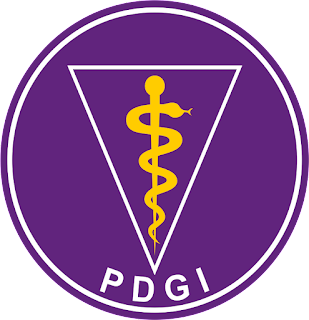THE EFFECTIVENESS OF RINSING WITH CELERY LEAFS (APIUM GRAVEOLENS L.) EXTRACT 10% AND CHLORHEXIDINE GLUCONATE 0.1% TO ACCELERATE POST-SCALING GINGIVITIS HEALING
Abstract
Background: Gingivitis is a periodontal disease caused by accumulation of bacteria plaque on the tooth surface. The primary treatment of gingivitis by removing its etiologic factors that found in phase I of periodontal therapy is scaling and plaque control. Healing process of gingivitis takes time, therefore sometimes using antimicrobial and antiinflamatory drugs as an adjunctive therapy is needed. The use of celery extract as mouthwash containing flavonoid (apiin and apigenin) works as antibacterial and antiinflamatory agent. The purpose of this study is to acknowledge the use of celery leafs extract (Apium graveolens L.) 10% and Chlorhexidine glukonat 0.1% as mouthwash to accelerate the healing process of gingivitis after scaling and root planing.
Method: Experimental study using pre and post-test control group design. Samples were taken from FKG UNMAS students and RSGM FKG UNMAS patients within the period that met the inclusion criteria of caries patients, male sex, age 18-25 years old, with exclusion systemic disease and undergo orthodontic treatment, denture or prosthesis others. Subjects have index teeth (11, 16, 26, 36, 31, 46) and willing to take part in the research. A total of 32 samples divided into two groups by simple random sampling technique. Group I as control group rinsing with chlorhexidine gluconate 0,1% after scaling and Group II as experimental group rinsing with celery leaf extract 10% after scaling
Result: The mean of gingival index pre-post treatment in group I: 1,29+0,11 and group II: 1,09+ 0,16. Data analyzed with independent t-test, and the results shows no significant difference between both group (p=0,071)
Conclusion: Gargling for three days showed no significant difference between gargling with celery leaf extract (Apium graveolens L.) 10% and chlorhexidine gluconate 0.1% because it was equally effective at treating post-scaling gingivitis.
Keywords
Full Text:
PDFReferences
Cobb, C.M, Microbes, Inflammation, Scaling and Root Planing, and the Periodontal Condition, Journal of Dental Hygiene, vol.82, no. 9, p.4-9(2008).
Cope, G, Ginggivitis: Symptoms, Causes and treatment, J Dental Nursing, vol.7, no. 8, p.436-439(2011).
Dewi, Fitri H. Pujo, Jati L. Leksana, E, Perbedaan Jumlah Bakteri Trakhea pada Tindakan Oral Hygiene Menggunakan Chlorhexidine dan Povidone Iodine pada Penderita dengan Ventilator Mekanik, Jurnal Anestesiologi Indonesia, vol. 4, no. 2, p. 127-134(2012).
Fiorellini, J.P. Kim, D.M and Ishikawa, S.O, Gingival Inflamation, in Carranza’s clinical Periodontology, Forrest et al. (ed), Ed. Ke-10, Sounders Co., St. Louis(2006).
Inna, M. Atmania, N. and Prismasari, S, Potential Use of Cinnamomumburmanii Essential Oil-based Chewing Gum as Oral Antibiofilm Agent, Journal of Dentistry Indonesia, vol. 17, no. 3, p. 80-86(2010).
Katzung B, Farmakologi Dasar dan Klinik, Salemba Medika, Jakarta, hlm.168-169(2004).
Newman, M.G. Takei, J.H. and Carranza, F.A, Carranza’s Clinical Periodontology, 9th ed., W.B. Saunders Co., Philadelphia, p. 97-100, 263-267(2002).
Pocock, S.J. Clinical Trials. A Practical Approach. John Wiley & Sons Ltd. West Sussex- England. p. 50-87(2008).
Sukandar EY. Suwendar. Ekawati, E, Aktivitas Ekstrak Etanol Herbal Seledri Dan Daun Urang Aring Terhadap Pityrosporum Ovale, majalah farmasi Indonesia, 17(1):7-12( 2006).
DOI: http://dx.doi.org/10.30659/odj.9.0.51-56
Refbacks
- There are currently no refbacks.

This work is licensed under a Lisensi Creative Commons Atribusi-BerbagiSerupa 4.0 Internasional.
Contact us: Odonto Dental Journal: Jl. Raya Kaligawe Km.4, PO BOX 1054/SM Semarang, Central Java, Indonesia, 50112. Email: odontodentaljournal@unissula.ac.id



